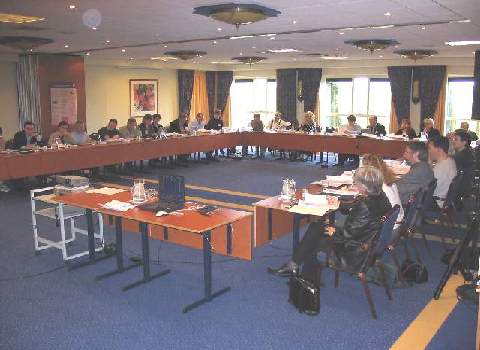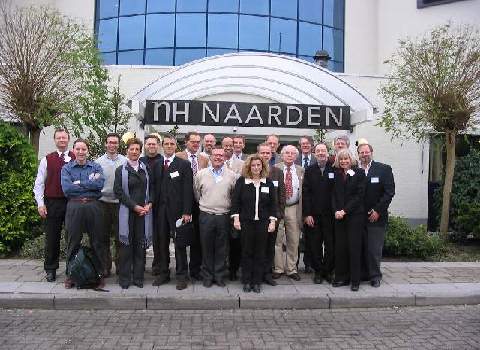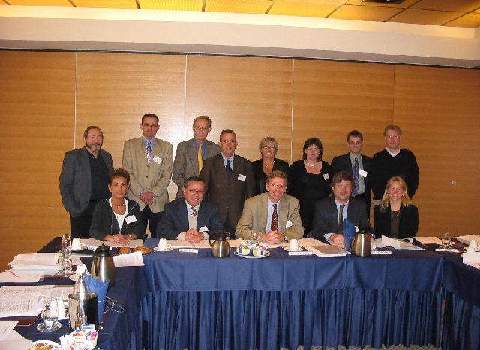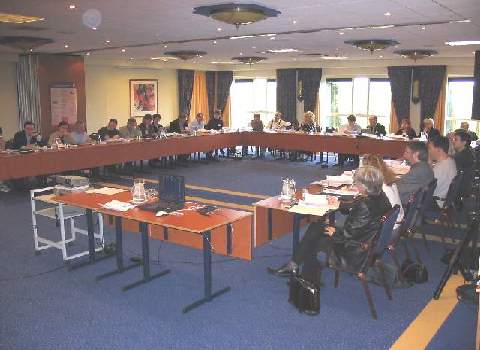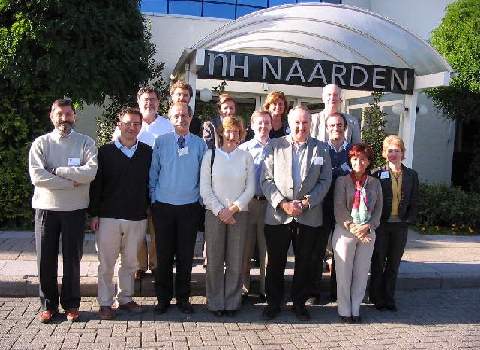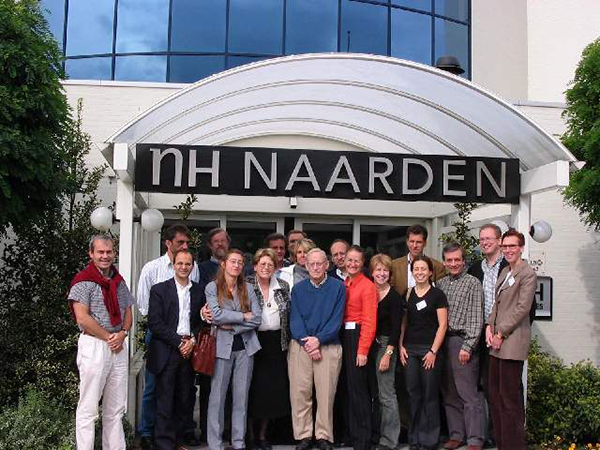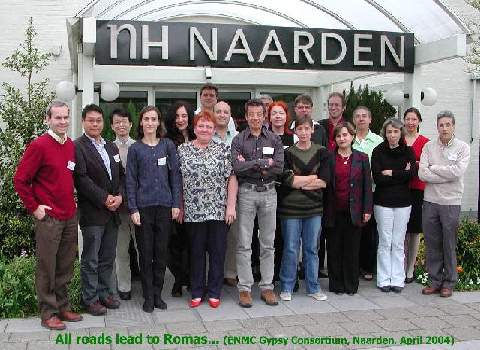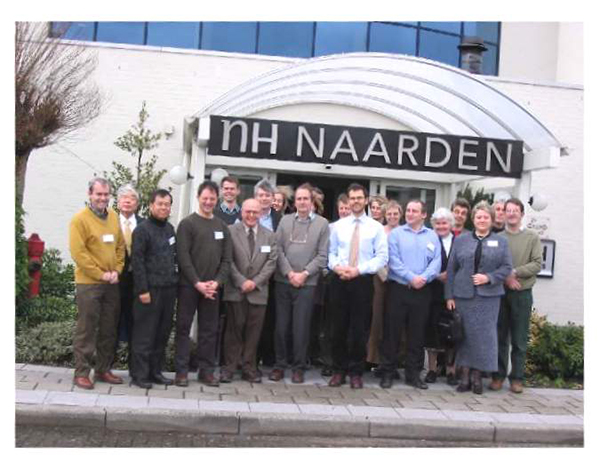35 participants representing parents, funding agencies and clinicians involved in the care of children with DMD from Belgium, Canada, Denmark, Finland, France, Germany, Italy, the Netherlands, Spain, Sweden, the UK and the USA met in Naarden from 2nd – 4th April 2004.
The meeting was held under the auspices of the ENMC Clinical Trials Network, and with the additional support of the United Parent Project. The aims of the workshop were to define the need for clinical trials in Duchenne Muscular Dystrophy (DMD) and develop a protocol for such trials, relating primarily to the use of steroids (prednisolone, prednisone and deflazacort) in DMD. The meeting heard that a major worry for parents is the lack of availability of steroids at all in some countries, the multiplicity of steroid regimes used and the problems of getting firm information about which type of steroid or which regime for using steroids was best.
This was reflected in the variation in practise amongst the participants at the Workshop, some of whom did not use steroids at all, and between the rest there were at least seven different regimes for giving steroids.
The meeting was divided into three parts. First, the evidence for the use of steroids in DMD was considered. Second, the meeting split into small groups for the development of various aspects of a protocol that could be used for a trial of steroids or for the monitoring of their use in clinical practice, and third a strategy to develop and fund a trial or trials in DMD were considered.
There can no longer be any doubt that use of steroids in ambulant children with DMD alters the natural history of the condition. Children treated with daily steroids are likely to walk for longer, have improved respiratory function, may avoid the need for spinal surgery and might have better heart function than untreated children. Benefits of starting steroids in children who have already lost ambulation are not yet established. The two main types of steroid used (prednisone/ prednisolone and deflazacort) appear to be equally effective.
Side effects seen with the long term use of steroids in DMD use include weight gain, (which may be less prominent using deflazacort) loss of height, asymptomatic cataracts (with deflazacort predominantly) and thinning and possibly fractures of the bones. Nonetheless, many centres have used daily steroids for many years, and ways to help to avoid or treat many of these side effects are available.
There are alternative ways to use steroids to try and minimise the side effects. These include giving a lower dose, or using steroids in an intermittent way (on alternate days, for periods such as 10 days on and 10 days off, or at the weekends only). The rationale behind using these other regimes is to give the body a rest from steroids at times, and/or with some but not all of the regimes to give a lower overall dose.
People using all of these different regimes report that they have a positive effect in improving strength and function in DMD. However none of them have been tested formally against daily steroids to see if there is a difference in how effective they are and what the actual level of reduction in side effects is.
It was agreed steroids are the gold standard of treatment in DMD against which other treatments should be judged. To provide answers on the relative merits of the different regimes a trial is needed to look at the efficacy and side effects of a range of regimes compared to daily steroid over a long period of time. Protocols were discussed that would allow differences in strength and function to be picked up and that would monitor for side effects while also trying to prevent them as much as possible. It was felt to be very important to monitor effects on quality of life as well as muscle strength and function. Alongside testing different steroid regimes, the ideal trial would also look at the best way to prevent the development of heart problems and protection of bone strength. As this trial will need to recruit large numbers of patients, a multinational effort will be required and different national funding agencies are likely to be involved.
In advance of this trial, it was felt that it would be useful to develop some basic advice about the monitoring and management of possible side effects of steroids in DMD. Problems with bone density and weight are two of the major concerns as children with DMD can have problems in these areas even without steroids. For example, even young children with DMD may have bones which are less strong than normal. This is believed to be because they are less active than other children. Exercise helps bones to grow strong, so boys with DMD should be encouraged to be active. It is also important for growing bones to have proper levels of vitamin D and calcium. The best way to achieve this is by diet and sunshine- supplements are not as well absorbed. Because of their weaker bones, boys with DMD may have a higher risk of breaking their bones, but they heal normally. It is though important that broken bones are treated with as short periods of immobilisation as possible.
Using steroids in DMD has multiple effects on bones. Increased strength leads to more exercise and can strengthen the bones. However, steroids are known to have a bone weakening effect and this may become more prominent with long term use. Again, diet and sunshine are currently the best way to try and prevent problems. Broken limbs in steroid treated boys can be treated the same way as boys not on steroids. In long term use of steroids some people have seen weakening or compression of the back bones and this can rarely cause pain, though it can be treated. The issue of prophylaxis for these problems will be the topic of further trials.
Weight is another worry for people using steroids. Boys with DMD sometimes have a tendency to too much weight gain. This may partly relate to their lower levels of activity. So the tendency to gain weight can be most when activity is declining. In itself, of course, increased weight can also make walking more difficult. Sweets and fast foods are best avoided where possible. Alternatives to these kinds of treats are available, and low fat or low calorie alternatives to many foods can be easily obtained. The need to control weight is even more important in children with DMD treated with steroids. Appetite increases immediately in many people who take steroids, and the family needs to be ready for that. The highest risk of weight gain on starting steroids is in the first few months so if particular attention can be paid to healthy eating at this stage and continued with the steroid treatment, problems may be less. Additional diet issues for children on steroids include adequate calcium and vitamin D.
Further patient information material will be prepared and disseminated.
During this workshop it was decided to generate information for parents and clinicians on the use of steroids in DMD and monitoring processes for efficacy and side effects. The current version of this information is available via this link.
Steroids and Duchenne Muscular Dystrophy (DMD) – some questions and answers
This workshop was organised by Prof. Kate Bushby (UK), Prof. Francesco Muntoni (United Kingdom), Prof. Andoni Urtizberea (France), Prof. Richard Hughes (United Kingdom) and Prof. Robert Griggs (U.S.A.).
Other participants were:
Dr. Anna Ambrosini (Italy), Dr. Anne d’Andon (France), Prof. Corrado Angelini (Italy), Dr. Carole Bérard (France), Dr. Enrico Bertini (Italy), Dr. Doug Biggar (Canada), Dr. John Bourke (United Kingdom), Dr. Jaume Colomer (Spain), Prof. Denis Duboc (France), Prof. Victor Dubowitz (United Kingdom), Dr. Michelle Eagle (United Kingdom), Prof. Brigitte Estournet (France), Dr. Kevin Flanigan (U.S.A.), Dr. Patricia Furlong (U.S.A.), Dr. Nathalie Goemans (Belgium), Dr. Imelda de Groot (The Netherlands), Dr. Sharon Hesterlee (U.S.A), Dr. Anneke van der Kooi (The Netherlands), Prof. Rudolf Korinthenberg (Germany), Dr. Adnan Manzur (United Kingdom), Dr. Richard Moxley (U.S.A.), Prof. Giovanni Nigro (Italy), Dr. Helena Pihko (Finland), Dr. Michael Rose (United Kingdom), Dr. Thomas Sejersen (Sweden), Ms. Birgit Steffensen (Denmark), Dr. Tony Swan (United Kingdom), Dr. Marcello Villanova (Italy), Ms. Elizabeth Vroom (The Netherlands) and Dr. Maggie Walter (Germany).
An extended report of this meeting has been published in Neuromuscular Disorders. You can access the report by clicking here.
